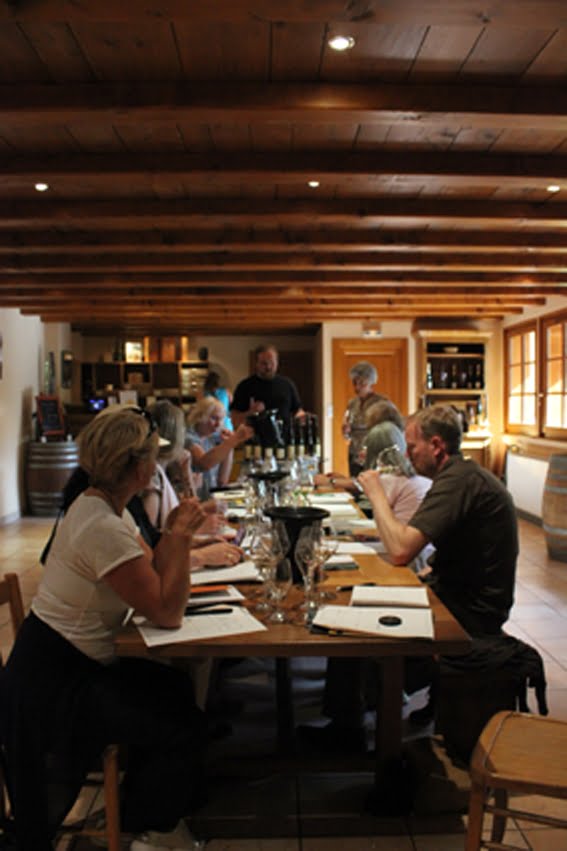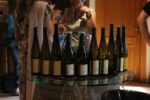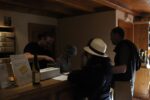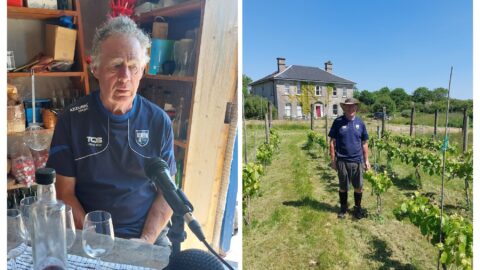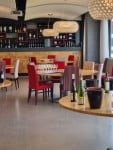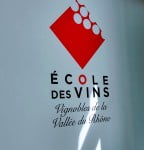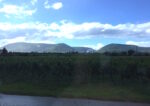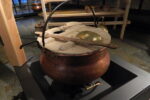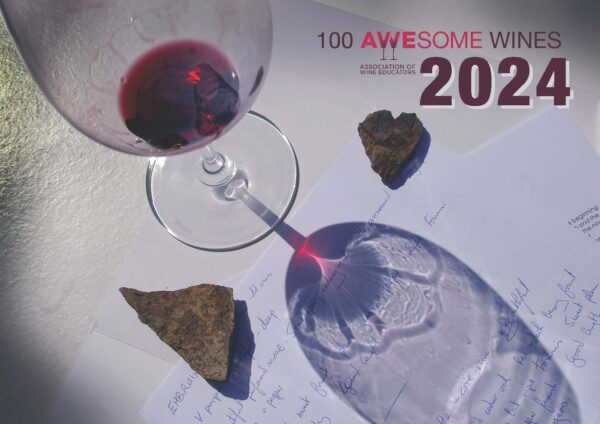As part of the AWE Study Tour to Alsace in July 2015 we were generously hosted by Dominique and Adrien Schoenheitz of Domaine Schoenheitz. This wasn’t the first time we’d sampled a selection some of their wares. Earlier the same day Dominique led us through a wine and cheese tasting at the local Maison du Fromage, creating and excellent opportunity to taste wines in situ. An extensive review of the wines/cheeses and their associated interactions having been expertly completed by Patricia Stefanowicz MW, this blog concentrates on the subsequent visit to the Domaine.
Located in Wihr-au-Val in the more southerly Haut-Rhin, Domaine Schoenheitz has been in existence since the early 1900’s, owing its current state to Henri Schoenheitz Senior who meticulously restored the vineyard area to its pre-war glory in 1970 after a period of mixed agriculture. Today the vineyard is managed by Henri Schoenheitz Junior and his wife Dominique, both oenology graduates, having their first vintage in 1980. The oenological talent recently swelled when son, Adrien returned from numerous viticultural and vinification stages around the world, adding an undeniably modern take and remarkably deft touch to the wealth of traditional winemaking experiences of mother and father.
The 16ha managed by Domaine Schoenheitz are located in the Munster Valley,which runs laterally to the Rhine giving the vineyards here a relatively novel southerly exposure. Although the Domaine does not incorporate any registered Grand Cru vineyards it does represent four lieux-dits or ‘named places’; Val-Saint-Grégoire, Linsenberg (stony with some clay), Holder (granite & clay) & Herrenreben (stony & sandy). Management of the vineyards adopts a minimal intervention approach. In the winery the approach is clinical, each vinification fine-tuned by style, variety, vineyard, vintage with real attention to detail. Of particular note was the use of oak for both the two Pinot Noirs and the Tokade (an oaked Pinot Gris). The wines showed great balance and integration with the oak influence adding great complexity without compromising the delicate fruit characters beneath. Adrien has had great influence here, showing an incredibly sophisticated touch belying his apparent age and experience. Having visited many other (highly) reputed producers during the trip it was this use of oak showing great boldness and sensitivity which really stood out. A full list of samples tasted and some brief notes follows:
Pinot Noir Herrenreben 2012
An excellent Pinot Noir showing wonderful fresh red fruit and subtle oak influence (12 months in French barriques, renewed by one quarter each year).
Pinot Noir Linsenberg 2012
A more intense Pinot Noir with a riper fruit character owing to the stonier, heat-retaining soils of the Linsenberg site. This additional intensity permits extended maturation in oak (12 months in French barriques renewed by one third each), adding some complexity and illustrating the aforementioned deft touch.
Crémant Brut NV
This 10% Pinot Blanc, 90% Pinot Auxerrois from vineyards on the valley floor showed great delicacy of fruit balanced by refreshing acidity. Domaine Schoenheitz choose to forgo any malolactic fermentation giving a zesty dry (5g/l) Crémant with added weight and texture from the vastly exceeded minimum ageing period of 24 months.
Crémant Zero Dosage 2007
Aged for 5 years on lees and with ‘no added sugar’, this was truly an excellent example of how serious Crémant d’Alsace can be. Zero dosage wines can often be overly austere; the abundance of autolytic characters added enormous complexity and creamy texture.
Riesling Herrenreben 2012
Purity of fruit and firmly structured acidity were common to all the Rieslings tasted from the individual lieu-dit. The fruit from stony Herrenreben gave ripe citrus and stone fruits with a more evident floral character supported with an almost prickly acidity – my favourite of the named sites.
Riesling Holder 2012
The Holder site is much less stony with a great deal more clay – generally given over to Gewurztraminer and Pinot Gris rather than Riesling. The Riesling grown was fatter, less delicate with a waxy nature to the fruit.
Tokade 2011
This is Adrien’s experiment – 100% Pinot Gris aged for 22 months in French barriques, renewed one third each year. The oak influence was pronounced here, but worked well with the ripe tropical fruit taken from the Holder vineyard. Although with excellent intensity and again a wonderful use of oak this dry style lacked some balancing acidity, better illustrated in the Domaine’s other wines.
Pinot Gris Holder 2012
This classic Alsatian style of Pinot Gris uses fruit from the Holder lieu-dit. It has lots of stone and tropical fruit with a relatively high level of sweetness (28.5g/l).
Gewurztraminer Holder 2013
Much of the clay-rich Holder site is taken up with Gewurztraminer. This particular example was wonderfully rich and floral; a great example of the region’s specialty.
Riesling Herrenreben SGN 2013
The tasting finished with an opportunity to sample a rare SGN – not produced at Domaine Schoenheitz since 2006 when conditions were last favourable. Adrien explained that even in 2013 the conditions looked doubtful – grape sugar levels being insufficient to meet the minimum potential alcohol level to label as an SGN. Astonishingly the final week saw the potential alcohol rocket from 14% to 21% producing a final wine with 173.6g/l of residual sugar. This hugely concentrated wine showed abundant dried tropical fruits and a beguiling array of botrytis aromas – namely rye and caraway; a superb finish to an excellent tasting.
My feeling that this was a selection of beautifully made wines demonstrating both variety and vineyard was evidently echoed by an array of locals. As we neared the end of the tasting both Dominique and two other staff members were whisked away to help process sales and transport goods to expectant cars. Although Domaine Schoenheitz is represented in the UK through Lea & Sandeman, their merchandising skills were again tested as many members of the AWE group formed an orderly queue to take advantage of the full range! My sincere thanks go to mother and son who presented their wines exceptionally, with special thanks to Dominique who had to endure the ordeal twice.
Tags: Alsace
